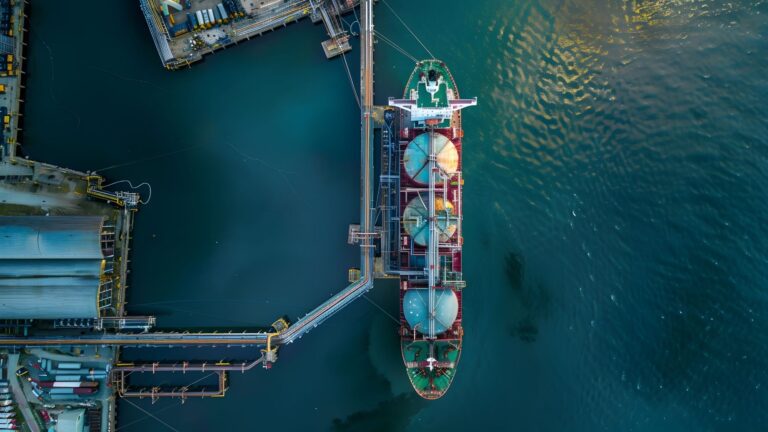
Patricia Tiller, an Energy Partner at Hunton Andrews Kurth, explores the role for LNG in the global energy transition, considering the environmental, economic, and regulatory hurdles to its uptake, along with innovative solutions and strategies to overcome these challenges.
Sharing insights into the soon-to-be-released new model form agreement, Patricia also looks at the drivers behind this agreement, highlighting the optionality and flexibility it offers for modern LNG contracts and how it can streamline and enhance LNG transactions.
Continued value
LNG’s continued value is assured because the technology (and affordability) of providing true net-zero energy does not yet exist on a large-scale basis. Utility scale batteries, used to even out renewable energy generation, are, currently, still too expensive to compete with gas as an energy source. Large-scale batteries, with reliable and cost-effective storage capacity for an extended period of time, are not yet commercially available.
Arguably, with today’s technology, even ‘clean’ energy such as solar power and electric vehicles (EVs) have a more detrimental impact on the planet on a life-cycle basis when compared to natural gas. Yes, the carbon dioxide output for solar and EV (once in use) is less than traditional fossil fuels, but that disregards the environmental impact of the production process for batteries and solar panels (and to recycle or dispose of them at the end of their currently short life-cycles).
Against that backdrop, LNG has two key roles in the energy transition:
- replacing more emissions-intensive fuels until renewable energy technologies evolve to provide a true net-zero energy alternative; and
- providing a cost effective, reliable, form of energy until renewable energy technologies can match the base and peaking power options provided by conventional power stations.
Whether the role of LNG is short-term or continues beyond 2050 will be determined by the regulation of emissions, which continue to favour renewable forms of energy.
LNG’s role in a renewable energy world As an energy projects attorney, I spend a considerable amount of time negotiating offtake agreements and sale and purchase agreements for energy commodities.
Increasingly, I am seeing LNG being considered not as a short-term transition fuel, but as an integral and ongoing aspect of an otherwise fully renewable power project. Successfully integrating LNG with renewable energy to produce a hybrid power project, such as combining LNG/gas-fired power with solar or wind power is not a new concept.
Together, energy production can be optimised, emissions can be reduced and the reliability of power supply can be enhanced. LNG as a feedstock will compensate for the intermittent nature
of renewable energy, helping to maintain grid stability until energy storage technology increases in efficiency and lowers in cost.
A more novel hybrid approach is using a renewable energy source to produce lower- emission LNG. By using a renewable energy source for powering LNG production trains, the overall emissions intensity of the LNG plant can be reduced, with early projects predicting up to 90% reduction in emissions produced during the liquefaction process of cooling raw natural gas.
A notable example is the Marsa LNG plant in Oman, a joint venture between TotalEnergies and the Oman National Oil Company that reached FID in April 2024. The planned Marsa LNG plant will be 100% powered by solar energy, making it one of the lowest GHG emissions intensity LNG plants ever to be commissioned with GHG intensity below 3 kg CO2e/boe (in comparison to the 35 kg CO2e/boe usually produced during liquefaction).
The key challenge – measuring the emissions intensity of LNG
Policy makers around the world have been quick to implement target GHG emissions. Where policy and practicality diverge is the measurement and reporting of emissions, and this is particularly true for LNG.
Standardisation of emissions across the full LNG value chain will be required before GHG reduction measures can effectively be applied to the sale and purchase of LNG. This requires measuring emissions and reporting that information in a widely accessible system across the upstream (natural gas exploration and production), midstream (liquefaction and shipping) and downstream (regasification/ natural gas pipelines/gas combustion) sectors.
LNG is traded as a global commodity, often on a portfolio basis, with limited (if any) interaction between LNG sellers and the energy companies exploring for and extracting the natural gas feedstock; and zero interaction between the LNG buyers and the producers of the natural gas.
Measurement of emissions before the liquefaction process can be especially challenging, particularly for US LNG export facilities liquefying LNG on a tolling basis. The LNG spot market, where LNG cargoes are purchased on short notice, will also struggle to obtain the information necessary to measure and account for the GHG emissions of a particular cargo.
Opportunities for new LNG projects to succeed are still there, but to fit into the low- carbon world, new projects will need to be able to measure and report GHG emissions throughout the value-chain. Further investment in methane reduction, and carbon capture will also be required.
AIEN Model Form LNG Sale and Purchase Agreement
The Association of International Energy Negotiators (AIEN, formerly Association of International Petroleum Negotiations or AIPN) will soon release the first model form long-term LNG sale and purchase agreement (LNG SPA). The AIEN model forms already include an LNG master sale and purchase agreement, but the new long-term sale and purchase agreement will differ from the LNG master sale and purchase agreement in several ways.
Firstly, the LNG SPA is designed to be used only for free-on-board (FOB) transactions (where the LNG buyer arranges shipping to the ultimate destination), and modifications to several key terms would be needed if the new model form agreement were used for cargos that are delivered by seller to a receiving port.
In an FOB sale, no long-haul shipping costs are included in the price and there is less control (if any) over destination restrictions on the carrier.
The LNG SPA will also include an extensive price review clause, with price review options of varying complexity, and an option that specifically prohibits price review. Prohibiting price review was discussed by the AIEN committee at length, and has been included as an option to clarify that if buyers/sellers are not interested in renegotiating the price during the term, then an express clause should be added to reflect this intention.
In many common and civil law jurisdictions, the courts would not allow price reopening given the high level of sophistication of parties in the LNG trade, but the express prohibition has been included as an option to ensure that a party’s intentions when entering the contract are not swayed by future circumstances (e.g. hardship of one party) that may lead to a mismatched desire to vary the previously agreed terms.
GHG-neutral LNG
Another new aspect of the LNG SPA will be the inclusion of a GHG-neutral LNG option, to reflect the growing trend for sellers to provide an emissions estimate and corresponding carbon offset units for the relevant cargo.
This optional clause will: (i) allow for seller and buyer to agree on a method for calculating equivalent carbon dioxide emissions generated during the LNG production process (likely starting from the point natural gas is produced at the wellhead, though this will be negotiable); and (ii) allow buyer to purchase carbon offset units for each cargo and have the carbon offset quantity retired in an agreed voluntary registry.
The LNG SPA model form is currently under final review by the drafting committee and is due to be published by Q4 2024.
As the world continues to seek cleaner, reliable and cheaper energy solutions, LNG will undoubtedly play a crucial role in shaping the future energy mix. In the short term, LNG will remain a key fuel in the global energy industry given that it offers a cleaner alternative to fossil fuels such as crude oil and coal.
The extent to which LNG maintains its market share long-term is under challenge by competing regulatory landscapes and lack of standardisation in emissions measurement and reporting, but I am quietly confident that LNG will continue to play an important role in net- zero goals beyond 2050.
Patricia Tiller is the managing partner of Hunton’s Dubai office and has over 16 years of experience advising participants in the energy industry. She advises on energy projects involving both conventional and renewable energy sources, including LNG import and export projects, upstream oil and gas exploration, and development of regulatory regimes for the distribution and sale of energy products.

Image credits: Dreamstime, Hunton Andrews Kurt

